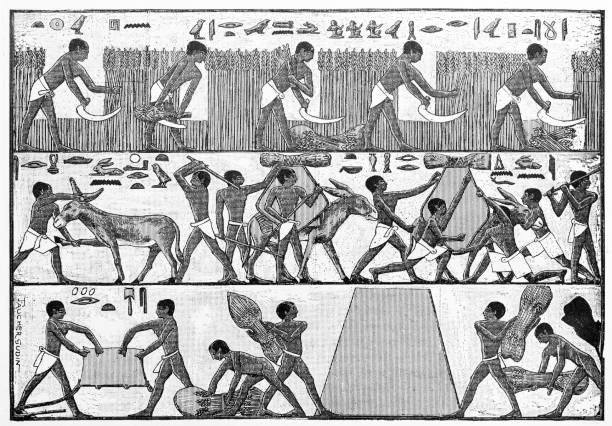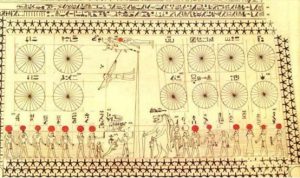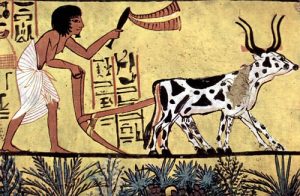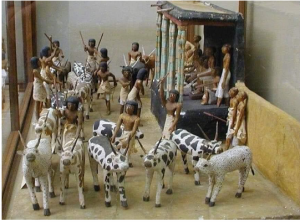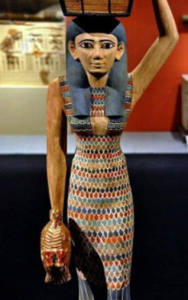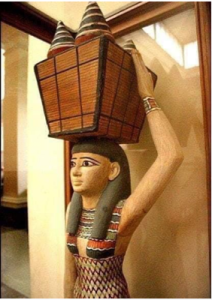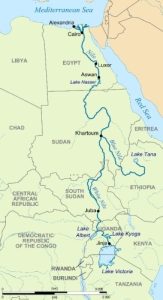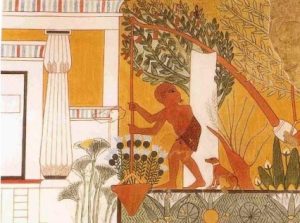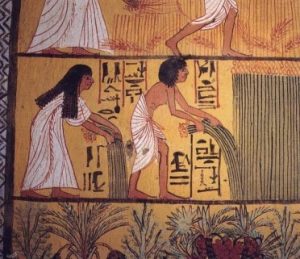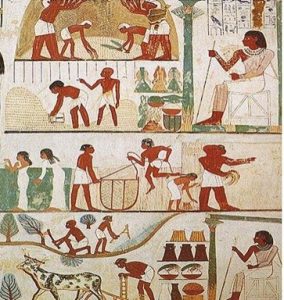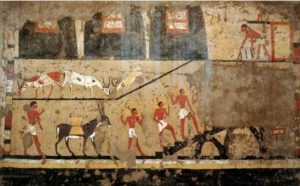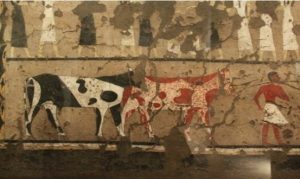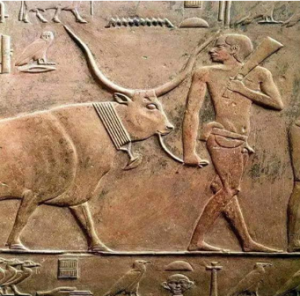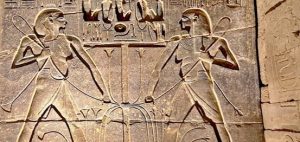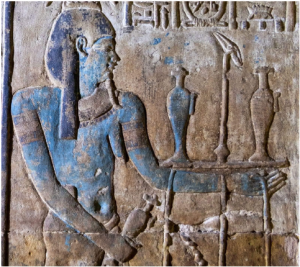Agriculture in Ancient Egypt
Agriculture was the lifeblood of ancient Egyptian civilization. The Nile River was the key to life for the ancient Egyptians, and it was along its banks that they lived to the east and buried their dead to the west. Agriculture introduced the concept of community formation to the ancient Egyptians. Along the banks of the Nile, Egyptians had to work together to combat the annual floods, leading to the development of teamwork and management skills. The staple diet of the ancient Egyptians consisted primarily of agricultural products, livestock that grazed on cultivated land, and poultry raised in their homes. The ancient Egyptian year was divided into three seasons, each comprising thirteen months (twelve months of 30 days and one month of 5 days). These seasons were closely tied to agriculture and were as follows: •The first season: This was the planting season and lasted for four months. •The second season: This was the season of cultivation and harvest and lasted for four months. •The third season: This was the flood season, lasting approximately four months. During this time, farmers would work on royal projects or construct tombs for high-ranking officials. As a result, women played a significant role in supporting their families by tending to livestock and milking animals.
Picture shows Ancient Egyptian Calendar
Preparing Land for Cultivation
Scenes of men tending to livestock in fields
A woman milking a cow in house
Egyptian woman helps her husband
The Egyptian woman helps her husband in the first, carrying the field crops, and in the second, raising wild birds at home
Land Ownership and Barter System
the pharaoh, who granted it to high-ranking officials, military commanders, and temples. Peasants worked these lands and received a portion of the harvest in return. The same was done by the priests of the temples with the peasants on the lands designated for the temple. The absence of a monetary system until the 6th century BCE led to a barter system. Goods were exchanged for other goods, such as grain for barley, or poultry for dairy products and oils.
Egypt is the gift of the Nile
While Herodotus famously stated that Egypt was the “gift of the Nile,” the truth is that it was the hard work of the Egyptian people that truly sustained their civilization. The Nile flowed through many lands, but it was only in Egypt that a great civilization flourished. This was due to the Egyptians’ ability. -The countries through which the Nile River passes until it reaches Egypt
Agricultural Tools and Harvesting
Agricultural Tools and Harvesting Ancient Egyptians divided their fields into plots and used tools such as hand axes, animal-drawn plows, and levelers to prepare the land. The shadoof, a simple yet effective device, was used to lift water from the Nile or canals to irrigate higher fields. Harvest time was a joyous occasion celebrated by all, including men, women, and children. Musical instruments, such as flutes, accompanied the festivities. To ensure food security, the Egyptians stored excess grain in granaries to provide for lean years. -A view of the use of the shadoof from the tomb of Ebouy in Deir el-Medina, Luxor
A view of a man and his wife harvesting papyrus – Senjem Cemetery in Deir el-Medina – Luxor
A view showing the process of plowing fields, harvesting crops, and threshing grains from the tomb of Nakht
Key Crops of Ancient Egypt
The most important crops for the ancient Egyptians were those used for food, such as wheat and barley. Barley was also used to make a type of beer, often along with fruits like grapes, figs, dates, and pomegranates. They also cultivated essential vegetables like onions, garlic, lettuce, and watercress. Additionally, fruits such as figs, grapes, dates, pomegranates, and many others were commonly grown. Oils were extracted from plants like sesame and sunflower. The Egyptians also utilized the lotus flower for perfumes and created paper from the papyrus plant. Flax was another significant crop, used to produce linen cloth. -A scene showing the transportation of grains to the silos after the harvesting process. The scene was found on the walls of the tomb of Iti and Neferu – displayed in the Museum in Turin, Italy.
Key Livestock and Animals
Livestock played a pivotal role in ancient Egyptian society, serving as a primary means of wealth. The quantity of livestock a person owned was a direct indicator of their prosperity. The government maintained detailed records of livestock populations to assess taxes. The most common livestock included cattle, oxen, sheep, and goats. Poultry, such as chickens, ducks, and geese, was also widely raised, often on specialized farms. Beekeeping was a well-established practice, providing honey and beeswax. The Nile River was a rich source of various fish species, including catfish, tilapia, sardines, and tuna.
A scene of a farmer returning home holding birds and animals following him
A view showing cattle breeding from the tomb of Ito and Neferu – Museum in Turin, Italy
One of the most beautiful scenes of offering sacrifices and social solidarity is a scene of a rich man dragging a bull to slaughter it in the temple, hanging a bell around his neck as an announcement of his slaughter as an offering to God and food for the poor
Egyptian Deities Associated with Agriculture
The ancient Egyptians revered certain deities due to their connections to agriculture. Among the most significant were: • Hapi: The god of the Nile, whose name means “the bringer of happiness,” the root of the English word “happy.” Hapi was often depicted enthroned, symbolizing the unification of Upper and Lower Egypt through the connection between the lotus and papyrus plants. •Sekhmet: The goddess of fields and fertility. •Renenutet: The goddess of harvest. •Sobek and Min: Deities associated with fertility and abundance. •Osiris: The god of the underworld, also connected to vegetation and the cycle of life and death. Egyptians expressed their gratitude for the bounty of the Nile through annual festivals. These celebrations involved offerings of food, such as cakes and fruits, as well as animal sacrifices and amulets, all intended to ensure the continued fertility of the river. Additionally, statues of beautiful women were placed near the Nile to encourage its fertility and the prosperity of the land. -A heavenly view (the unification of the two lands). The god Hapi connects the papyrus and the lotus, symbols of the south and the north

